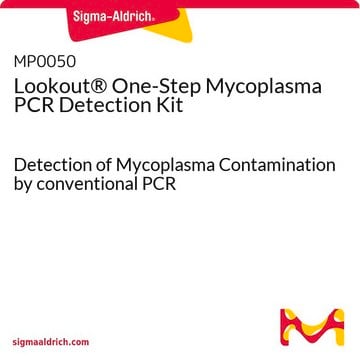MP0035
LookOut® Mycoplasma PCR Detection Kit
Optimized for use with JumpStart™ Taq DNA Polymerase, D9307.
Synonym(s):
PCR-based mycoplasma screening
Sign Into View Organizational & Contract Pricing
All Photos(1)
About This Item
UNSPSC Code:
12352207
NACRES:
NA.75
Recommended Products
quality
Not suitable for clinical diagnostic use. Will not detect clinically relevant species such as M. pneumoniae and U. urealyticum
Quality Level
packaging
pkg of 1 kit
technique(s)
PCR: suitable
application(s)
detection
microbiology
compatibility
Optimized for use with JumpStart™ Taq DNA Polymerase, D9307.
storage temp.
2-8°C
General description
The LookOut® Mycoplasma PCR Detection Kit utilizes the polymerase chain reaction (PCR), which is established as the method of choice for highest sensitivity in the detection of Mycoplasma, Acholeplasma, and Ureaplasma contamination in cell cultures and other cell culture derived biologicals. Kit has been successfully tested for the ability to amplify Mycoplasma fermentans genomic DNA in concentrations of 20,000 to 20 copies.
The reaction tubes included with the kit are pre-coated with appropriate dNTPs, primers, and loading dye. Total assay time is greatly reduced compared to general protocols that require individual loading of reaction tubes.
The reaction tubes included with the kit are pre-coated with appropriate dNTPs, primers, and loading dye. Total assay time is greatly reduced compared to general protocols that require individual loading of reaction tubes.
Application
The LookOut® Mycoplasma PCR Detection Kit has been used for screening of mycoplasma infection.
Compatibility
The kit has been optimized for use with Product No. D9307. Any DNA polymerase with a 3′-5′ exonuclease activity is NOT recommended. These include Tli, Pfu,and Pwo. Those DNA polymerases that may be used include Taq, Tfl, and Tth.
Legal Information
JumpStart is a trademark of Sigma-Aldrich Co. LLC
LookOut is a registered trademark of Merck KGaA, Darmstadt, Germany
related product
Product No.
Description
Pricing
Storage Class Code
10 - Combustible liquids
Flash Point(F)
Not applicable
Flash Point(C)
Not applicable
Choose from one of the most recent versions:
Already Own This Product?
Find documentation for the products that you have recently purchased in the Document Library.
Customers Also Viewed
Soudabeh Rad Pour et al.
Frontiers in oncology, 10, 51-51 (2020-03-03)
Dysregulation of the kynurenine pathway has been regarded as a mechanism of tumor immune escape by the enzymatic activity of indoleamine 2, 3 dioxygenase and kynurenine production. However, the immune-modulatory properties of other kynurenine metabolites such as kynurenic acid, 3-hydroxykynurenine
Nellie Moshkovich et al.
Cancer research, 80(11), 2125-2137 (2020-04-09)
Peptidylarginine deiminases (PADI) catalyze posttranslational modification of many target proteins and have been suggested to play a role in carcinogenesis. Citrullination of histones by PADI4 was recently implicated in regulating embryonic stem and hematopoietic progenitor cells. Here, we investigated a
Dmitri Pchejetski et al.
Cancer research, 70(21), 8651-8661 (2010-10-21)
Radiotherapy is widely used as a radical treatment for prostate cancer, but curative treatments are elusive for poorly differentiated tumors where survival is just 15% at 15 years. Dose escalation improves local response rates but is limited by tolerance in
Arun Vaidyanath et al.
Stem cell research, 45, 101765-101765 (2020-04-22)
Two iPSC clones, NCCSi008-A and NCCSi008-B, were generated from a healthy male individual of Indian origin by reprogramming his CD4+ T cells with an integration free Sendai viral vector. The established iPSC clones showed high alkaline phosphatase (ALP) activity, expression
Chao-Chieh Lin et al.
Cell death and differentiation, 27(7), 2234-2247 (2020-01-29)
The molecular and genetic basis of tumor recurrence is complex and poorly understood. RIPK3 is a key effector in programmed necrotic cell death and, therefore, its expression is frequently suppressed in primary tumors. In a transcriptome profiling between primary and
Our team of scientists has experience in all areas of research including Life Science, Material Science, Chemical Synthesis, Chromatography, Analytical and many others.
Contact Technical Service








